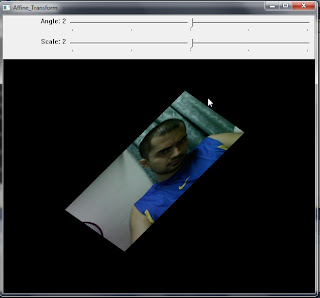
An affine transform allows the user to warp, stretch, rotate and resize an image or a footage from a camera. Essentially the image is multiplied by 2x3 matrix to perform the transformation. An affine transform produces parallelograms (which includes standard rectangles).
#include <opencv2/video/tracking.hpp>
#include <opencv2/highgui/highgui.hpp>
#include <stdio.h>
#include <opencv2/objdetect/objdetect.hpp>
#include <opencv2/features2d/features2d.hpp>
#include <opencv2/highgui/highgui.hpp>
#include <opencv2/calib3d/calib3d.hpp>
#include <opencv2/imgproc/imgproc_c.h>
#include <opencv2/video/tracking.hpp>
#include <iostream>
#include <vector>
int angle_switch_value = 0;
int angleInt = 0;
int scale_switch_value = 0;
int scaleInt = 0;
void switch_callback_a( int position ){
angleInt = position;
}
void switch_callback_s( int position ){
scaleInt = position;
}
int main(int argc, char** argv)
{
// Set up variables
CvPoint2D32f srcTri[3], dstTri[3];
CvMat* rot_mat = cvCreateMat(2,3,CV_32FC1);
CvMat* warp_mat = cvCreateMat(2,3,CV_32FC1);
IplImage *src, *dst;
const char* name = "Affine_Transform";
//create capture
CvCapture* capture = cvCreateCameraCapture(0);
for(;;)
{
IplImage* src = cvQueryFrame(capture);
dst = cvCloneImage( src );
dst->origin = src->origin;
cvZero( dst );
cvNamedWindow( name, 1 );
// Create angle and scale
double angle = 0.0;
double scale = 1.0;
// Create trackbars
cvCreateTrackbar( "Angle", name, &angle_switch_value, 4, switch_callback_a );
cvCreateTrackbar( "Scale", name, &scale_switch_value, 4, switch_callback_s );
// Compute warp matrix
srcTri[0].x = 0;
srcTri[0].y = 0;
srcTri[1].x = src->width - 1;
srcTri[1].y = 0;
srcTri[2].x = 0;
srcTri[2].y = src->height - 1;
dstTri[0].x = src->width*0.0;
dstTri[0].y = src->height*0.25;
dstTri[1].x = src->width*0.90;
dstTri[1].y = src->height*0.15;
dstTri[2].x = src->width*0.10;
dstTri[2].y = src->height*0.75;
cvGetAffineTransform( srcTri, dstTri, warp_mat );
cvWarpAffine( src, dst, warp_mat );
cvCopy ( dst, src );
switch( angleInt ){
case 0:
angle = 0.0;
break;
case 1:
angle = 20.0;
break;
case 2:
angle = 40.0;
break;
case 3:
angle = 60.0;
break;
case 4:
angle = 90.0;
break;
}
switch( scaleInt ){
case 0:
scale = 1.0;
break;
case 1:
scale = 0.8;
break;
case 2:
scale = 0.6;
break;
case 3:
scale = 0.4;
break;
case 4:
scale = 0.2;
break;
}
// Compute rotation matrix
CvPoint2D32f center = cvPoint2D32f( src->width/2, src->height/2 );
cv2DRotationMatrix( center, angle, scale, rot_mat );
// Do the transformation
cvWarpAffine( src, dst, rot_mat );
cvShowImage( name, dst );
cvWaitKey( 15 );
}
cvReleaseImage( &dst );
cvReleaseMat( &rot_mat );
cvReleaseMat( &warp_mat );
return 0;
}
Comments
Post a Comment